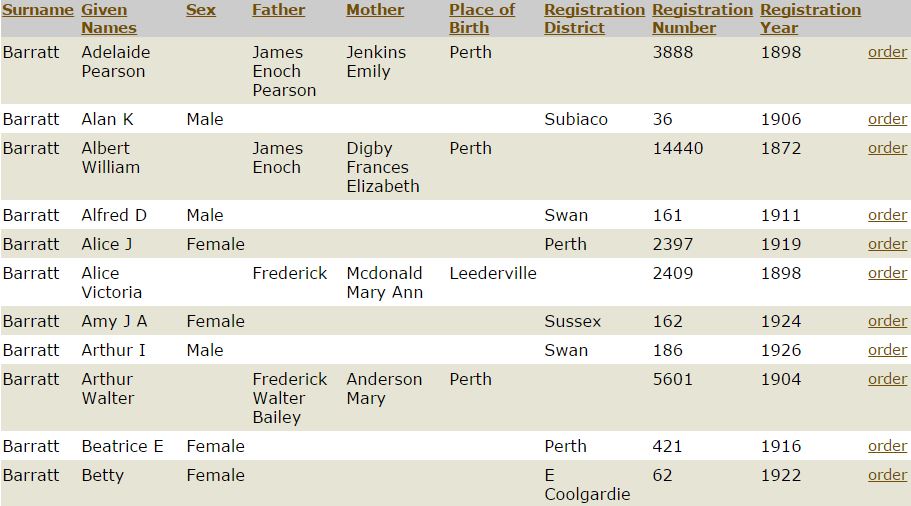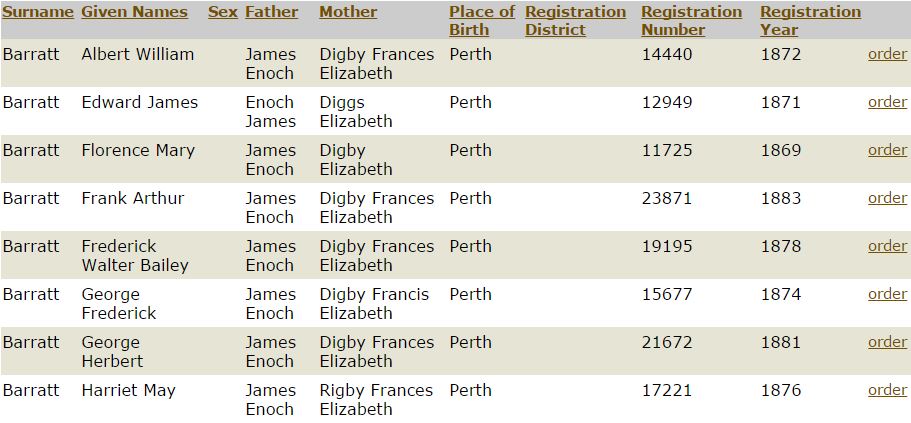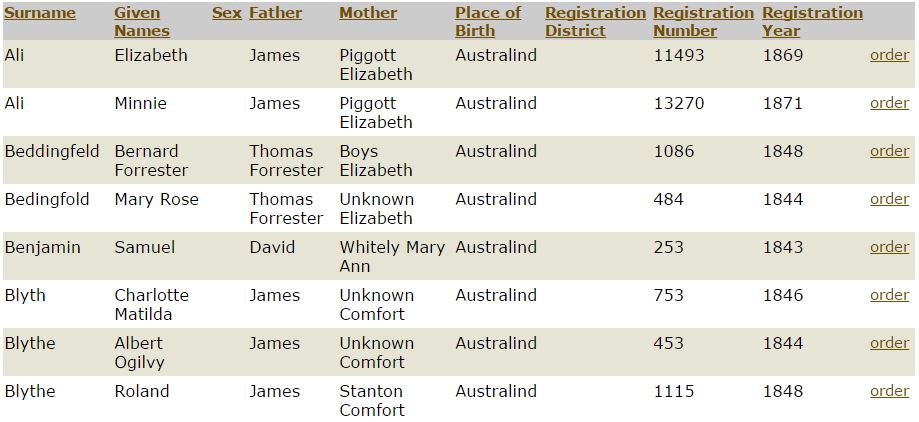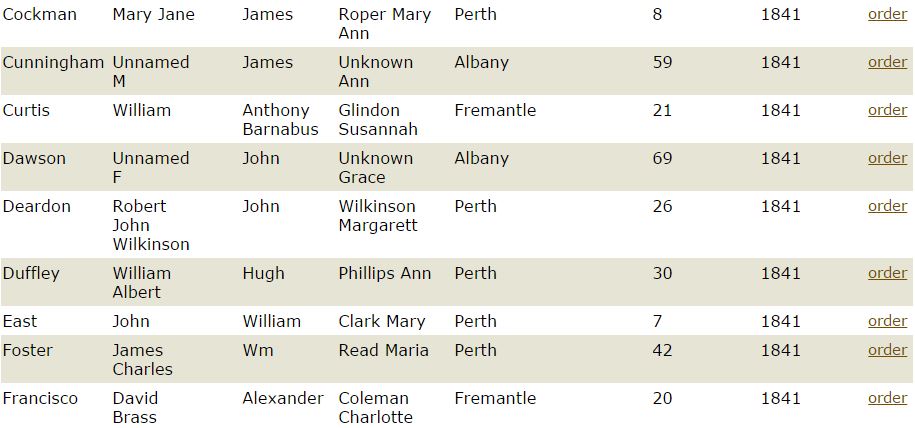
Collie Courthouse and Registry of Births, Deaths and Marriages for the Wellington District circa 1911. Courtesy of the State Library of Western Australia (BA579/206).
From the very beginning, when I first started to dip my toes into genealogical research, the Western Australian Registry of Births, Deaths and Marriages website was one of my key websites for finding my ancestors. I still continue to use their indexes and consider it one of the best resources for Western Australian family history.
It’s not the prettiest website; there are no bells and whistles that make it stand out and catch your eye but what it lacks in aesthetics, it makes up in functionality. Their searchable indexes for births, deaths and marriages in Western Australia are described as ‘reversible’. This means that you can search in a variety of different ways, or, as Willy Wonka described the way in which the Wonkavator travelled:
…[it] can go sideways, and slantways, and longways, and backways… and squareways, and front ways, and any other ways that you can think of.
In this blog post I’ll be sharing the ways in which these indexes can be searched, from the more common techniques to the not-so-common.
The website for accessing the Western Australian Birth, Death and Marriage indexes is: http://www.bdm.dotag.wa.gov.au/_apps/pioneersindex/default.aspx
Clicking on a particular button (births, deaths or marriages) loads the search fields.

So that this post is not repetitive, I will be utilising the birth index for my examples. While the fields are slightly different, the various search techniques are essentially the same and can be applied to either index.
The most common way to search the indexes is simply by surname. Enter the name into the box corresponding to ‘Family Name’ and click search.

This will bring up all the results associated with that particular surname but it doesn’t bring up names that may be listed under a slightly different spelling. I.e. entries listed as Barrett instead of Barratt.
While searching using only a surname is handy if you have a relatively uncommon name, scrolling through page after page will become cumbersome if you’re searching for a very common name such as ‘Smith’. This is when you should look at adding additional fields such as a first name.

In the above example, I added the name ‘Edward’ in the ‘Given Name(s)’ field and searched with the surname ‘Barratt’. There are two available entries, the second one is my 2nd Great Grandfather. If you would like to order a copy of the certificate, you may wish to click the ‘order’ link on the far right of the entry on the website. This will then load a (partially) pre-populated order form for you to complete and post to the Registry Office.
Having found the relevant entry, you may wish to try and find other siblings. To do this without having to scroll through the entire list of registrations, keep the surname entered, remove the first name from the box (leave it blank) but add the name of the father (perhaps just his first name) to the box ‘Name of Father’. To refine it further, add the mother’s name to the field ‘Name of Mother’. In the example below, I added the names James (first name) and Elizabeth (middle name).

Eight out of the nine children born to James and Frances are listed. Where is the ninth?
Initially you may find that obtaining results is easy peasy. But it’s at this point when you need to remember to think outside the box. If you know there is another way in which your surname is spelt, try the other spelling. Other relatives (who have had their names registered with the incorrect spelling) may be missed if you don’t try other versions.

The above image shows James and Frances’s ninth child, Edith, incorrectly recorded as ‘Barrett’ instead of ‘Barratt’.
What if you don’t know how many children your ancestors had and you don’t want to continuously enter different types spellings? This is the beauty of the reversible search – remove the surname or enter only the first initial or first part of the surname. I know Barratt can be spelt several different ways but I also know it always starts with the letter ‘B’.
The results below show three surname registrations starting with ‘B’ whose father and mother have James or Frances somewhere in their name.

It’s important to note that these types of searches and results only apply to birth registrations up to 1905. Birth registrations after this year do not include the names of the father and mother and searching using this method will not produce results.
But what if you don’t know the names of the parents? Enter the surname in the box (completely or partially), type in the first name and then, enter in the approximate range of years you believe your ancestor was born. E.g. I know my Great Grandfather’s name was William Nicholson and that he was born around 1901 but I don’t know who his parents were. I would enter William’s surname and first name and then, in the box for ‘Year of Birth’, I would enter the years 1900 and 1904. The results would show all the William Nicholsons whose births were registered between the years 1900 and 1904, of which there’s only one:

Now, here is my top piece of advice relating to searching the Western Australian indexes:
You are not limited
Curious about any illegitimate children within the family? Enter a surname and then enter the mother’s surname as being the same as the child’s. Often illegitimate children were listed with the mother’s maiden name and may not have the father listed at all.

Are you researching a particular place and hoping to find records relating to all births there? Remove all search fields relating to surnames, first names etc and only enter the place of birth. E.g. in the below image I searched for all births in the town of Australind.

Wondering about the number of births registered in 1841? Enter only the dates 1841-1841 in the ‘Year of Birth’ field and click search. Incidentally, 47 results are listed (not all shown below).

Apply these same techniques when using the death and marriage indexes. Enter surnames, first names, years – the world really is your oyster.
If you’re forever curious (much like me) enter the word ‘unknown’ into either name box. The list of people who were unknown to authorities is phenomenal. Many times I’ve looked through the list, often wondering who they were and what stories they had to tell. Wondering if there was a way in which research could help make them ‘known’ again.

I’ve provided you with several different examples on how to use the Western Australian Birth, Death and Marriage indexes but once again I’m going to reiterate: you are not limited. Seriously, play around with the index. Even if it’s got nothing to do with your family history research, try different search combinations and see what crops up. You might be surprised by what you find.
Happy searching!
Sources:
- Image courtesy of the State Library of Western Australia (http://encore.slwa.wa.gov.au/iii/encore/record/C__Rb3507786?lang=eng).
- Willy Wonka & the Chocolate Factory on IMDB (http://m.imdb.com/title/tt0067992/).


Are we able to share these notes in our groups Newsletter with acknowledgment from where it was obtained please? Judith
Hi Judith,
Yes, please feel free to share these tips in your newsletter. 😊
Jessica
Excellent explanation Jess – you can alsmost manipulate the Qld BDM th e same way
Thanks Neville! Yes, you’re right. Queensland’s index is very similar. 😊
Hello Jess, Thankyou again for such a detailed email to help your followers with their genealogical researching. After Ron and I independently read it we wished we were younger and more equipped to continue our research for our ancestors. Hopefully our descendants will one day have the interest to do so. Have you been able to find any of Enoch’s ancestors? Thankyou again for helping us to apply for Ron’s grandparents Frederick Walter Bailey Barratt and Mary Anderson’s marriage certificate which arrived quickly. The little ‘key keep’ is almost complete, hopefully helping future custodians of the clock and keys to safely keep them together. Have you knowledge of the ‘Rajah Quilt’ ? Probably one often most significant textile pieces to have survived from convict times. A very interesting Google. The plight of female convicts and free settlers was so harsh during and after their transportation. I am fascinated how they were able to make a new life, with nothing much in a new colony. My attempt at viewing the Rajah Quilt eventually happened about two years ago at the Brisbane Art Gallery. I had spent about ten years trying to view it as it was either not on display because of its fragility or at one stage sent to the UK for an exhibition. It is stored at the Canberra Art Gallery. I spent a long time standing in front of the quilt trying to imagine the experience and hardship the women were enduring on their long journey to the unknown. The little blood stains on the quilt from pricked fingers was a touching addition to the experience. I believe there is ongoing analysis of the quilt, possibly DNA tracing of the blood for descendants. Amazing! I have waffled on long enough. Keep up the good work Jess, I have a feeling it’s your passion. A joy to read for us. Kindest, Gerri
Sent from my iPad
>
I have included your blog in INTERESTING BLOGS or GENERAL INTEREST in FRIDAY FOSSICKING at
http://thatmomentintime-crissouli.blogspot.com.au/2017/03/friday-fossicking-3rd-march-2017.html
Thank you,
Chris
Thanks Chris. 😊
Hi Jess. Just a quick note to mention that I sent you an email on Cartys of Cloughjordan on Feb 17th, just wondering if you had received it?
Hi Mary,
Yes I did receive it and was meant to reply earlier but it completely slipped my mind. Please accept my apologies. I will reply to you today.